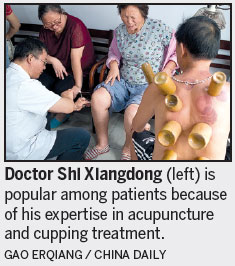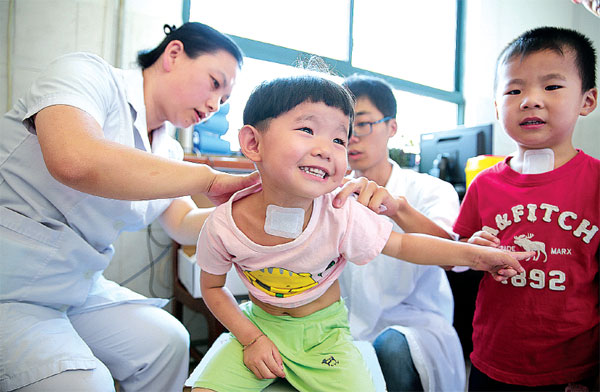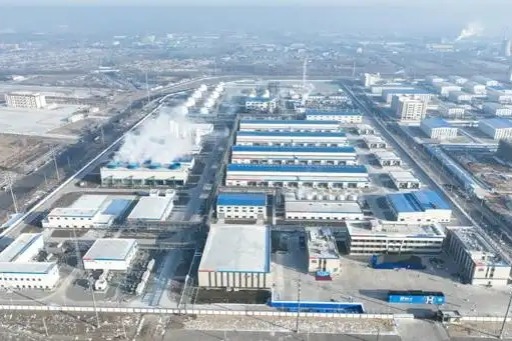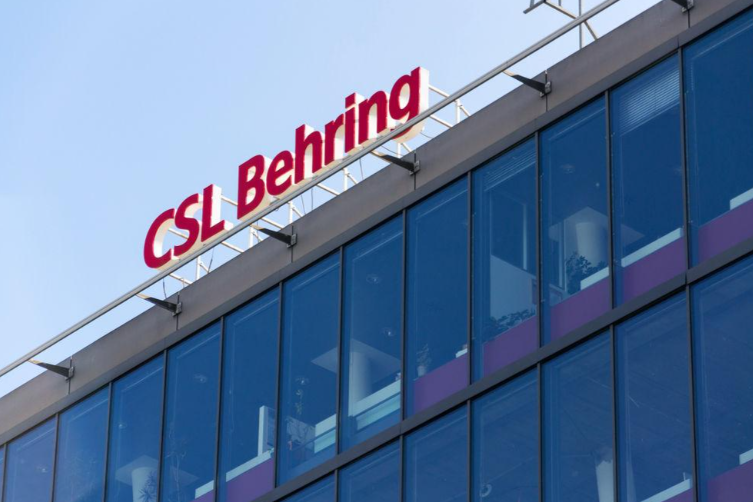Treating ailments, the ancient way

Summer marks a time when people flock to receive plasters and moxibustion therapy for illness
The number of young people seeking traditional Chinese medicine treatments for illnesses at hospitals in summer has been on the rise in recent years. The Chinese generally believe that TCM treatments are more effective during summer because this is when yangqi - the warm element in the yin-yang balance - is at its highest and hence allows the body to be more responsive to treatment.
Longhua Hospital and Shuguang Hospital, both of which are affiliated with Shanghai University of Traditional Chinese Medicine, reports that the number of patients in their 30s and 40s lining up to receive sanfutie plasters this summer grew by at least 30 percent from last year. However, elderly citizens and children still dominate a lion's share of the market for these herb-coated plasters that are placed on acupoints.
| Children line up to receive sanfutie plasters. Chinese generally believe receiving treatment when the weather is warm will help cure illnesses more effectively. Provided to China Daily |
These plasters are commonly used to treat ailments such as rheumatism, asthma, chronic bronchitis and allergic rhinitis. The remedy was first documented in Zhangshi Yitong, a book published more than 300 years ago.
TCM practitioners say that the fast pace of life in megacities such as Shanghai has also contributed to the growing popularity of sanfutie plasters. They say the plaster can be used as a prevention against problems common among young white-collar workers, such as neck and shoulder pain, insomnia and gastrointestinal discomfort.
"Many white-collar workers in Shanghai have to deal with great pressure at work, get little sleep and often skip meals," says Liu Jianguo, director of the TCM department at Shanghai Ren'ai Hospital. "This in turn affects their health in the long run."
Cai Mengsha, 30, used to suffer from frequent stomachaches and nausea, a result of years of working overtime and excessive alcohol consumption. She says her health has improved after using sanfutie plasters for three years.
"The treatment administered over the last few summers seem to be effective in alleviating the discomfort. Doctors say the treatment requires three years of constant application in order to be effective," says Cai, an employee at a foreign enterprise in the automotive industry.
At Liang Gong Guan, a chain health institution that offers moxibustion therapy, TCM practitioners say 80 percent of their clients are aged between 30 and 45 years old.
Moxibustion therapy involves burning sticks filled with dried wormwood leaves close to the body to warm meridian points and stimulate the circulation of blood and qi.
"The rise in the number of young people seeking treatment is due to the heightened awareness of health issues today and a preference for nondrug treatments," says Xie Youming, a therapist at Liang Gong Guan.
"For an acute health problem, such as neck or waist pains, results usually appear after just one or two treatments. For chronic issues like insomnia and period cramps, patients will need to receive treatment for at least three months or longer before they feel the difference," he says.
The rise in popularity of moxibustion had driven 35-year-old Lu Ge to set up a company selling products related to the treatment. He says that many people these days are performing the treatment on themselves, since it is cheaper. The most important part of the treatment is finding the right acupuncture points to warm using the moxibustion sticks. Lu says there are many books that teach people how to locate these points.
Lu has also, since February, been running a subscription service on WeChat to educate users about moxibustion. It currently has more than 6,000 active followers.
He explains that the treatment is popular because many perceive it to be a solution to many health problems related to qi, or life energy, that are brought about by modern lifestyle, such as staying up late, eating greasy food and being exposed to air conditioning all day.
zhouwenting@chinadaily.com.cn
The famous doctor everyone wants to see
Shi Xiangdong, a doctor at the traditional Chinese medicine department of Huayang Community Hospital in Shanghai's Changning district, receives more than 12,000 patients a year. Such is his reputation that many of his patients travel two hours from remote districts to be treated by him.
"Patients have to make an appointment with me at least three months in advance because I simply have too many patients to handle," says the 48-year-old.

Shi handles multiple patients at any time. A row of timers on the wall helps him to keep track of the time left for each patient's treatment. He starts working around 7:30 am and doesn't stop until five hours later. Mou Lili, 70, who started receiving treatment from Shi seven years ago for neck pain, says he is unlike most TCM doctors.
"Doctors will usually only work on the part of the body that experiences discomfort, but Shi applies treatment on the relevant meridian systems all over your body after checking your health situation by feeling the pulse and pressing different parts of the body to see if you feel sore," she says.
Since 2013, 24 common TCM treatments have been used in more than 300 community hospitals in the city. Many of these treatments are used in alleviating pain. Shi says that many patients who suffered pains because of lumbar disc protrusion were healed without the need for surgery because of acupuncture coupled with electric stimulation.
"In most cases, I'm confident a patient who cannot turn his or her head will be able to do that after acupuncture treatment and massage for 15 minutes," he says.
"Acupuncture and massage are very helpful for middle-aged and senior residents, many of whom suffer pains in the neck, shoulders, legs and other parts of the body. When people get older, there is an increasing need for such treatments," says Shi.
Shi says that TCM treatments can be effective in treating health problems that do not cause pain, such as insomnia, hair loss, hives, allergic rhinitis, myopia and even depression.
For patients suffering from insomnia, Shi uses acupuncture and a special massage technique that dates back more than a century. The focus for the treatment of depression lies in healing the liver, which affects the flow of qi, or life energy.
(China Daily Africa Weekly 09/08/2017 page18)
Today's Top News
- Experts: Lai not freedom fighter, but a pawn of the West
- Hainan evolves as gateway to global markets
- Opening up a new bridge between China and world
- Tour gives China-Arab strategic trust a boost
- China accelerates push for autonomous driving
- Opening of new gateway can help foster global economic and trade cooperation































